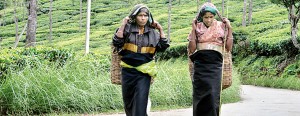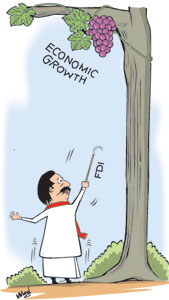Biochar: Can it put the tea industry back in the black?
By Dr. J.C. KrishnaratneView(s):Over the last several decades the tea industry in Sri Lanka has been buffeted by many factors, both external and internal. But largely internal. This essay will however concentrate on one major internal factor, the condition of soils in tea lands and technologies now available for bio-remediation.
Neglect, non-adherence to basic cultural practices and ever increasing costs of fossil fuel based fertilizers has resulted in overexploitation and degradation of the tea bush, a vital asset of the tea industry. So much so, that it would not be incorrect to compare a tea bush to a drug addict. Miss the regular dose and the addict goes into a shock, unable to function. Today, the tea bush is like that, an addict. A reduced, or miss ed dose, and the plant’s productivity drops.
ed dose, and the plant’s productivity drops.
In a sense, the soil today is only a medium to hold the plant up, requiring all nutrients to be fed from external sources. Over the years, the increasing cost of chemical fertilizers has contributed to this condition, with most of the smallholders having no choice but to cut down on fertilizer application.
This is exacerbated by planters having to compromise on other essential cultural practices as trenching and burial of prunings and maintaining soil conserving contour drains. In earlier days, the insistent shout of the Periya Dorai during rainy spells was “I want to see white water!” He was referring; of course, to surface water run off turning the stream brown as the best top soil was washed away. We have let the top soil go, and letting it happen, lament the fact that production is down.
The need then is to improve crop production, improve quality, reduce the cost of production and improve estate productivity. One might say a long task.However, a technology or a combination of related technologies is in fact available now, and being trialed, to reach a pragmatic solution to regenerative agriculture. Such a bio-remediation programme has been carried out over the last two years in selected tea estates.
The recorded data shows that sustained increase in leaf production in excess of 25% to 30% can be achieved after reducing fertilizer input by 50%. The difference has been more when a long dry spell follows a period of average rainfall with variances going up dramatically to over 70% between treated and control plots. During periods of rain, a noted tendency is for that gap in difference to become lesser. The interpretation is that application of Biochar helps the tea bush to last through dry periods better than the untreated ones and this fact is believed to be significant in view of the changes in climatic conditions that are taking place.
What then are these combined technologies that could assist the primary agriculture based industry of the country?
Biochar. The recently published definition of Biochar by the International Biochar Initiative states as follows: “a solid material obtained from thermo chemical decomposition of biomass in an oxygen limited environment”.
In practical terms, this is the pyrolising (decomposing organic compounds by heating to high temperatures in the absence of oxygen) of the biomass of plant origin from a stable carbon for application in soils as a means to sequester carbon as a major climate change mitigation tool.Further, Biochar systems at all scales can help solve the global food crisis by enhancing soil fertility and avoiding greenhouse gas (GHG) emissions.
Biochar is pyrolised at low temperatures in the range of 650 to 750 degrees Celsius. It is therefore heat stabilized and participates very little in any further chemical reactions in the soil and residence periods are counted in centuries to millennia. There is evidence for this in the Amazonian black soils or Terra Preta Do Indio.The Biochar placed two years ago under the trials under discussion was retrieved for examination recently. No change to physical size and form were noticed.
Other than the stated environmental and climate benefits, the specific agricultural benefits come from retention of nitrogen and water.
The present trials have shown that reducing down to 50% of recommendations has not impacted on yields but in fact still gives an increase of 25% or more in terms of plucked leaf. Further trials must and will be carried out to determine the maximum possible reduction of fertilizer input without compromising output.
In addition to the above-described characteristics of Biochar particles, there are other advantages for using Biochar in cultivating tea.
There has been a steady increase in demand for organically grown tea. One reason for the reluctance shown by growers is the three to five year conversion period required before obtaining organic certification. Not many RPC’s have the financial capacity to last through the crop loss period. For tea smallholders who contribute around 60% of the country’s tea production and tea is their major source of income, waiting this period without governmental support would be out of the question. Present field data indicates that the reported ability of Biochar to absorb and neutralize harmful pesticides could possibly contribute to reducing organic certification qualifying period by half the period now required.
To recapitulate, Biochar pyrolisers produce within the process – gas, liquid and solids. Syngas and biofuels can displace fossil fuels as energy sources and is in effect a renewable energy source. The final product is the solid content – Biochar. Because of its proven long residence period in soil, Biochar has been accepted worldwide as qualified material for carbon sequestration and can be traded for carbon credits under the clean development mechanism (CDM) of the extended Kyoto protocol. Sri Lanka is a signatory and has ratified the protocol. Depending upon the grade of Biochar produced, now classed as Grade 1, Grade 2 and Grade 3, at stable organic carbon content of 60% or more, 30% to 60%, and 10% to 30% respectively (1.0 MT of Biochar equals 3.3 MT of CO2 equivalent).
Gliricidia.
At a later date, we studied Gliricidia as a renewable biomass to produce Biochar. The positive factors which came of this study are numerous.Gliricidia (S. watahira, wetamara, Ladappa) is a ubiquitous plant of the deciduous family which is literally grown all over the country. It is not native to Sri Lanka, having been brought to the country by Christian missionaries, bringing it from the equatorial regions. In Sri Lanka, the only limiting factor to its successful establishment is the elevation factor. It does not do well above 2,000 metres.
It is a short rotation coppicing (SRC) plant and harvesting can commence 18 to 24 months after cuttings have been planted during rainy weather.When planted at 1m by 1m spacing, as a dedicated energy crop, it gives a stand of 8,000 plants… Harvested twice a year, yields up to 20 MT\H can be obtained.
In recognition of its value as a renewable fuel wood, the government, some years ago, gazetted Gliricidia as the fourth plantation crop after tea, rubber and coconut to have a subsidy scheme applicable to nationally important plantation crops.� Although cultivation of Gliricidia in coconut estates is not as widespread as it should be, conversely tea plantations have made a practice of growing this for low shade in the mid and low grown regions, and loppings are necessary, twice a year, just prior to the setting-in of the rainy period, to control the shade factor. It was the view held by the late Dr. Ray Wjewardene that there were 1,500,000 million acres of land in the North and East, which were sparsely used or unpopulated, and could not sustain any meaningful agriculture activities due to agro-climatic and soil conditions.
The fact that tea estates already carry significant planted stocks of Gliricidia biomass and the availability of a large extents of non-irrigable lands in the North and East of the country makes it possible to have different systems of deploying pyroliser plants. A significant improvement to the Gliricidia planting density can be carried out on tea estates, especially low growns as it has been noted that many vacancies exist in the bush count per hectare. These vacancies can be planted with Gliricidia as its root system hosts biological nitrogen fixing microbes and the land can only benefit from this plant, even if it is for a short period until programmed in-filling is carried out.
Deploying pyrolising plants
Under serious consideration are small skid mounted plants (processing operations) which are to be deployed covering a grouping of estates within a given region and where the feed stock could be transported from a maximum radius of 20 km. Even in the event of a shortfall of feed stock from within the group, there already exists a bought leaf operation in the estates which could be adapted and employed to fill the short fall.
In the North and East, agro-climatic conditions, present vegetation cover and demographic situation makes it possible to deploy high production capacity static plants set in the middle of a dedicated plantation of Gliricidia. Here, the scenario would be to set up a Gliricidia growers’ cooperative to whom the required extent of state land is alienated and to whom the available planting subsidy could be granted. Each settler family could cultivate three hectares of Gliricidia. Until the plantation gets established and foliage reduces sunlight and also after each harvest of feedstock, inter row cultivation of pulses and grains as sustenance crops is possible. This is also the case with engaging in animal husbandry for additional income generation.
On the assumption of 20,000 kg per hectare times three hectares, based on a guaranteed price of Rs. 5 per kg, each family could earn an annual income of Rs. 300,000 after the second year from planting. Many other cascading benefits, including economic and social, have been factored into a program of this nature.
The plant operator’s prime responsibility is to ensure the setting up of a central nursery to supply the seed or planting material for initial planting and supply of vacancy filling material, set up and operate the pyroliser plant, and above all to make payment for delivered raw material on time. It goes without saying that the government authorities have their own specific role to play in providing health, education and necessary infra-structure.
Conclusions based on trials
A combination of Biochar – pyrolised Gliricidia, with microbial inoculants applied at the correct time (after pruning), in the correct manner (trenching and placement in Rhizosphere) – brings immediate and long term benefits to the plantation industry. This may well be the combination of locally available technologies that the tea industry needs so badly to improve crop and quality in order to ensure that the pure Ceylon tea brand is preserved for the future, without having to import tea for blending.
(The writer is Director R&D at the Biochar Initiative Co. and can be reached at smilingsoil@gmail.com).
comments powered by Disqus















